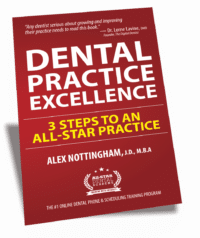Weekly Motivational Moments with Eric Vickery: Learn how to increase case acceptance with this 3-part series. This week Eric discusses using open-ended questions!
Resources:
About Eric Vickery
Eric holds a degree in business administration and brings a strong business and systems approach to his consulting. His initiation into the field of dentistry was in the area of office management. He managed dental practices for over ten years and has been consulting over 250 offices nationwide since 2001.
Episode Transcript
Transcript performed by A.I. Please excuse the typos.
00:03
Hi friends, welcome to your weekly motivational moments with Eric Vickery, president of coaching at All-Star Dental Academy. Today and this week, I want to talk to you about open-ended phrases during your emotional exam, your emotional swat that we started talking about last week. This is part two of a part three series that we’re going to cover on making your emotional conversation, your emotional exam more effective. And so many of you again are using this conversation.
00:32
And I wanna just help you raise the bar on how you do this, the results you’re getting. So last time we met, we talked about a powerful introduction and this time I wanna talk about powerful questioning. And so open-ended phrases that allow you to get more information from the person you’re communicating with. You can use this at home, you can use this with your team members and you can use this absolutely with your patients. This is where we’re focusing in today. So as you do your open-ended phrases, think about…
01:01
S, strengths, W, weaknesses, O, opportunities. Strengths, weaknesses, opportunities, and that’s SWOT. Strengths are likes, weaknesses, dislikes, opportunities, ideal. So wrong way to phrase this would be, all right, so what do you like about your smile and your teeth? All right, what don’t you like? Is there anything you like? Can you tell me what you like? Okay, what type of questions are those?
01:28
Right, those are yes or no questions. You’re gonna get yes or no answers. Even if you said, what do you like? It’s not a yes or no, but they’re gonna say things like, nah, nothing I can think of. People will take the path of least resistance. Now, you have set yourself up for a promising conversation by doing a powerful introduction. This would be the second part of helping you get the right results. So, remember, people buy for their reasons, not your reasons, and those reasons typically are emotional ones, because people buy with emotion, justify with logic.
01:57
So I’m looking to get to a what and a why. We’re just gonna talk about the what this week. And then part three next week, we’ll talk about finding the why. So to get there, you’re gonna use open and in phrases. So what does that mean? Well, four phrases, tell me, describe, share with me, or explain. These are phrases that you can use all over the place. But in this situation, S, they’re likes, right? Joey, describe.
02:26
for me, everything you like about how your teeth look and how they function.
02:32
Well, I don’t know about what I like, but they can go right into what they don’t like. But very rarely can they say nothing I think of, but they’ll do something. They’ll force the dialogue. They’ll follow along with you as you create this dialogue by using this questioning. So the W, the dislikes, right? That would sound like share with me everything you feel like are a challenge or it’s a concern for you that we ought to be aware of when it comes to how your teeth look and how they function.
03:03
and share with me, describe, tell me, explain. Oh, ideal, right? That’s the oh. I say, paint me a picture. Describe for me exactly, tell me exactly, share with me exactly what it would look like and how it would function if it were ideal. Oh, well, I would, this would look this way, this would feel that way, some sort of look good, feel good combination. Now you’ve got something to go on. They’re actually starting to treat a plan for you. Now they don’t.
03:30
diagnosed, they don’t know everything that’s going on up there that you’re going to be diagnosing, but they get the ball rolling for you. And that’s what we want. We want the patient already moving that conversation. Think about a patient who has a diastema. You just ask them, do you like it or do you not like it? Tell me everything you like about your smile. Oh, I love this space. People are always talking about how to close this space up. They’re always talking about aesthetics. I’m not worried about it. I love it. You’re going to find out things like this. Somebody who has not that great looking teeth, but you don’t really know how to bring it up to them and say, wow, your teeth really look, you know.
04:00
and you don’t want to say it, let them say it by describing everything they don’t like. So four phrases, share with me, describe, tell me, explain. Those phrases will help you create more dialogue this week during your emotional exam. So all right, guys, have fun with this. Talk it out as a team. Make sure you coach one another. Ask each other for feedback on how you’re doing with this as you hear your teammates using this.
04:27
We hope you enjoyed this episode of Dental All-Stars. Visit us online at allstardentalacademy.com








